Written by Nathanel Amar
The production of posters and graphics is an essential component of underground musical communities. It helps create a shared visual identity that people will immediately recognize (the practice of punk collage for instance, derived from the Dadaist movement), and it allows the musical community to circulate news of concerts pretty easily. To produce posters, the resources that a musical community has to possess are relatively few: some basic notions (and sometimes none at all) of drawing and design, and access to a cheap photocopier. When punk-rock bands began to form in China in the mid-1990s, they had to create their own resources, by negotiating with bar or KTV owners, or by sharing the stage with the more established rock’n’roll community. The posters produced by punk bands reflected the lack of financial resources, and the (perhaps sometimes forced) DIY (Do-It-Yourself) spirit that characterized the Chinese punk community. Early punk posters, dating back to 1996, can be found in the memoirs of David O’Dell, an American exchange student who witnessed firsthand the birth of Chinese punk rock, like these ones for a concert by UnderBaby (Dixia Ying’er) and Catcher in the Rye (Maitian shouwang zhe) in 1996 and 1997.
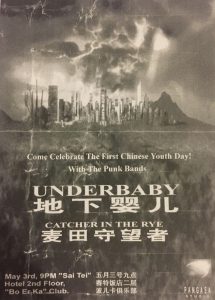
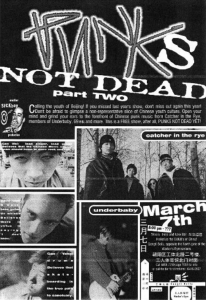
Photos Early punk
The opening of the Scream Club (Hao jiao julebu) in the university district of Haidian in 1998, a live venue and bar dedicated to punk-rock concerts, changed the way punks represented themselves in the posters they produced. The advent of the “Boredom Army” (or “Boredom Contingent”, Wuliao jundui), a punk collective comprised of four bands, Brain Failure (Nao zhuo), 69, Anarchy Boys (Wuzhengfuzhuyi nanhai) and Reflector (Fan guangjing) gave a more DIY twist to the posters. They were handwritten and cheaply photocopied in black and white, sometimes colored by hand, showing different elements of the punk style: Mohawk hairstyle, Dr. Martens boots, tattoos and offensive drawings.
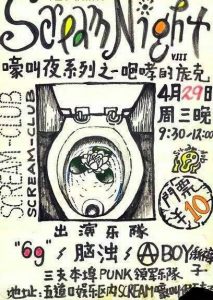
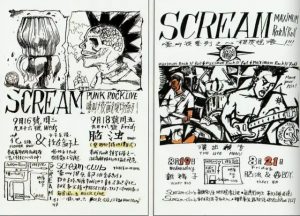
Photos Scream Club
At the same time, 1000 km south of Beijing, the city of Wuhan was also experiencing the birth of a punk community. The first Wuhan punk bands, as SMZB (Shengming zhi bing), SDL (Si dou le) or Shit Dog, had to perform in universities and KTV before being able to open their own live venues – like the short-lived Boy Toy opened by Kang Mao, the singer of SUBS, and afterwards the VOX Livehouse, created by Zhu Ning, the drummer of SMZB. These different posters produced by early Wuhan punk bands show a similar style to the one drawn in Beijing for the Scream Club, and also that they had to perform in universities.
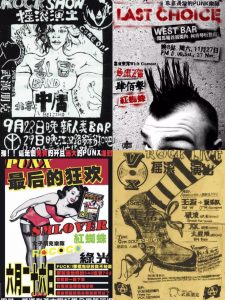
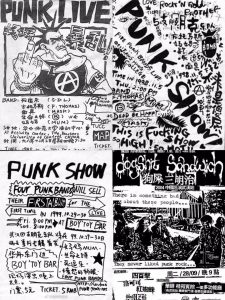
Photos Wuhan punk
Of course, sometimes punk rock shows doesn’t even have to display a poster. Sometimes a cardboard in front of the live venue will suffice, like for this show featuring the Beijing punk-rock band Joyside and the Taiwanese rock band MayDay (Wuyue Tian) in 2004 at the Wuming Gaodi for 30 yuan, which is funny, because MayDay is now an extremely famous band touring the world (the cheapest ticket for their Taipei tour in 2020 is at roughly 230 yuan).
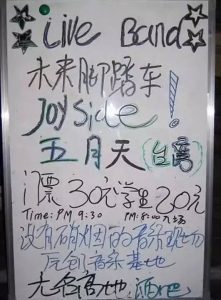
Photo Joyside x MayDay
With the development of the music industry since the 2000s, new underground and independent live venues opened throughout China. Among these venues, the D22, opened by Michael Pettis in the Beijing university district, played a major role for the local indie music scene, but also for the graphic identity of underground bands. The professionalization of live venues also meant that posters and graphic design were handed out to young independent designers, such as Cult Youth, a young collective of artists which produced comic books and posters for punk-rock bands, active between 2007 and 2011. Chairman Ca (Ca zhuxi), one of the founder of the Cult Youth collective, still contributes to the visual identity of underground bands by producing posters and album covers. As Josh Feola and Michael Pettis put it in an article published on Maybe Mars’ website in 2017, “[Chairman Ca] work, taken together, presents a fabulist and phantasmal, stream-of-consciousness narrative of Beijing’s early 2000s sex-drugs-and-rock’n’roll revolution, a cultural matrix where young punks are elevated to the level of deities and demons, espousing a value system invented on the fly and based primarily on a loud, visceral rejection of their parents’ culture.”
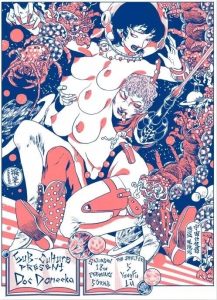
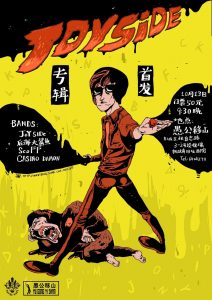
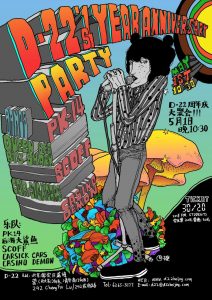
Pictures from D22 and Cult Youth
Different live venues have also different styles regarding poster and graphic designs. Venues such as School in Beijing, DMC in Tongzhou, VOX and Wuhan Prison in Wuhan, all have distinctive features when it comes to punk shows, sometimes adopting the old-school handwritten style of the 1990s. Much of the posters show a masculine vision of the musical underground. Men are over-represented in the drawings, while women’s bodies are overly sexualized – if not fetishized. The recent increase of all-female bands – something that has existed since the 1980s with the rock band Cobra and afterwards with the punk bands Hang On The Box in Beijing and No Pass in Wuhan – has brought about some changes in the visual representation of the musical underground. For instance, this poster made in 2013 for the “Power Girls Hot Night” (Nvhai yaogun zhiye) organized at the School Bar in Beijing, shows two punk women sharing a cigarette.
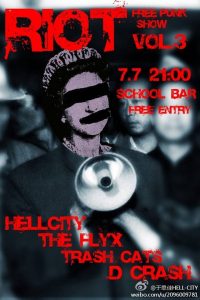
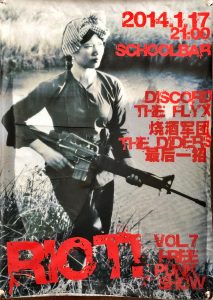
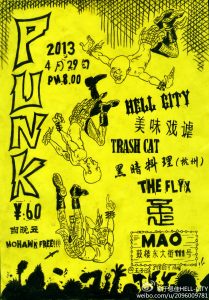
Photos from School, DMC, VOX, Wuhan Prison
Punk festivals are also an important moment for punk communities. Now these fests are organized in different parts of China, from Beijing and Wuhan to Shanghai, Chengdu or Chongqing. The graphic designs of these shows also display the political engagement of the bands, for instance the DMC Punk “Fucktival’s” poster is a parody of the Strawberry Festival organized by the music label Modern Sky in Tongzhou – which did not include any punk band. The 2014 “Beijing Drunk Fest” – also at the DMC – promoted a clear DIY spirit, to denounce the then “Beijing Punk Fest”, sponsored by Dr. Martens.
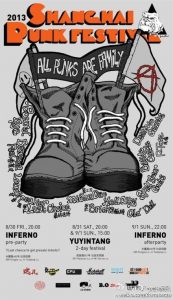
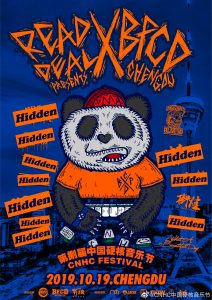
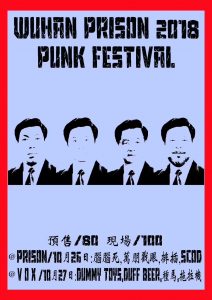
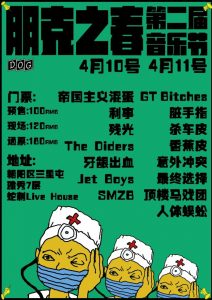
Photos of Punk Fests
Analyzing the posters produced by the punks can help us retrace their story, from handwritten posters, cheaply produced in the 1990s, to more professional posters created after the development of (underground) live-venues in major Chinese cities. It also shows that DIY spirit is still central to some bands and live venues, when they want to publicly display their “authenticity”.
Nathanel Amar did a comparative ethnography study of punk communities in China during his PhD. After a postdoctoral fellowship at the University of Hong Kong, he is now the Director of the French Centre for Research on Contemporary China office in Taipei. He recently edited the special issue of China Perspectives on Sinophone musical worlds. Image credit: the author.
- TV Drama Discourse on Stay-at-home Fathers in China: Super Dad & Super Kids - January 28, 2022
- Freud and China - January 20, 2022
- “Cultural China 2020″—A Different Take on China - January 7, 2022
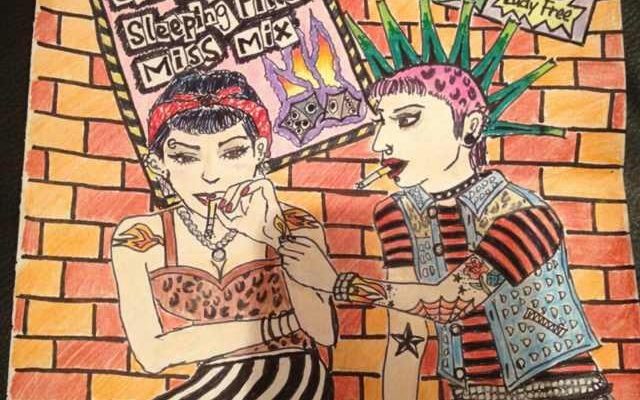
[…] fourth piece, written by Nathanel Amar, takes a look at visual identities of Chinese punk rock through posters. Amar argues that by […]
Let me know next time you do a piece like this. I have by far the best archive of music-related club posters, tour posters, zines, tickets, t-shirts, set lists, etc. from the Beijing music scene (along with stuff from other music scenes in China) during the 2005-2015 period, and I am always happy to make it available to anyone interested in this amazing period of music and art.
Thanks for getting in touch, Michael. We’d be delighted to talk to you about that. Will be in touch!
Hey! I’d be really interested in accessing all the information you listed here. I’m currently in the throes of writing a undergraduate research paper on the Chinese independent scene, focusing mainly on Beijing Punk. I should be carrying out an interview with Nevin Domer in the coming weeks 🙂 Let me know if you could make these materials available to me. I would also love to shoot you an email if I am able to and if that is acceptable.
Hi Michael; Richard Todd here, ex of Handsome Black and RandomK(e), hope you are well. I am thinking of putting together a little documentary on both of my Beijing bands. I’m not a film maker, just someone who has now realised I should have been a much better archivist 🙂 I’m not sure if HB ever played D22, I don’t think we did…but I know versions of RandomK(e) certainly did. I was wondering if I might be able to get a look at what you have on the K(e), whether it be posters, tickets, photos, videos, even audio. We have a lot already because Jackosn Garland was pretty good at that stuff, as was John Campbell but anything at all you could give me access to would be appreciated. I am in Phuket now but am coming back to work in Beijing again after leaving in 2019; are you stillm active in music venues or promotion? Anyway, any advice or feedback welcome. Cheers